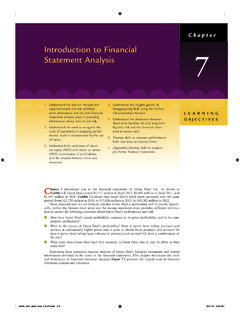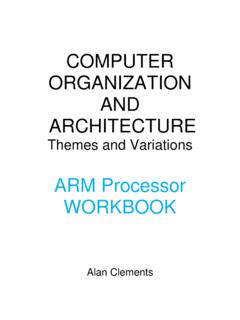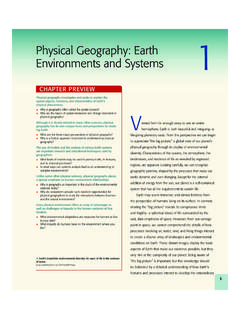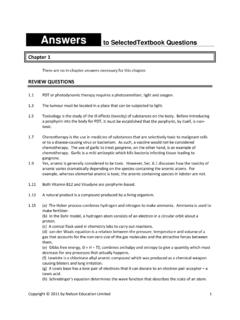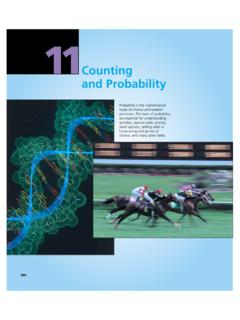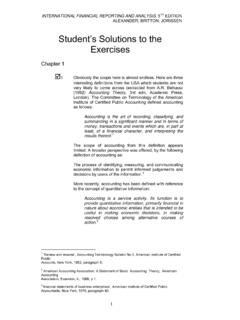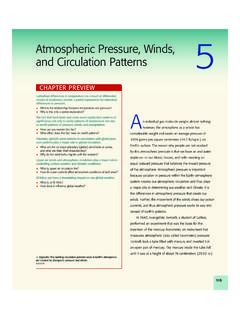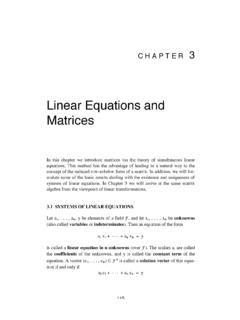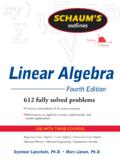Transcription of Elementary Linear Algebra - Cengage
1 Elementary Linear Algebra SIXTH EDITION. RON LARSON. The Pennsylvania State University The Behrend College DAVI D C. FALVO. The Pennsylvania State University The Behrend College HOUGHTON MIFFLIN HARCOURT PUBLISHING COMPANY Boston New York Publisher: Richard Stratton Senior Sponsoring Editor: Cathy Cantin Senior Marketing Manager: Jennifer Jones Discipline Product Manager: Gretchen Rice King Associate Editor: Janine Tangney Associate Editor: Jeannine Lawless Senior Project Editor: Kerry Falvey Program Manager: Touraj Zadeh Senior Media Producer: Douglas Winicki Senior Content Manager: Maren Kunert Art and Design Manager: Jill Haber Cover Design Manager: Anne S. Katzeff Senior Photo Editor: Jennifer Meyer Dare Senior Composition Buyer: Chuck Dutton New Title Project Manager: Susan Peltier Manager of New Title Project Management: Pat O'Neill Editorial Assistant: Amy Haines Marketing Assistant: Michael Moore Editorial Assistant: Laura Collins Cover image: Carl Reader/age fotostock Copyright 2009 by Houghton Mifflin Harcourt Publishing Company.
2 All rights reserved. No part of this work may be reproduced or transmitted in any form or by any means, electronic or mechanical, including photocopying and recording, or by any information storage or retrieval system without the prior written permission of Houghton Mifflin Harcourt Publishing Company unless such copying is expressly permitted by federal copyright law. Address inquiries to College Permissions, Houghton Mifflin Harcourt Publishing Company, 222 Berkeley Street, Boston, MA 02116-3764. Printed in the Library of Congress Control Number: 2007940572. Instructor's examination copy ISBN-10: 0-547-00481-8. ISBN-13: 978-0-547-00481-5. For orders, use student text ISBNs ISBN-10: 0-618-78376-8. ISBN-13: 978-0-618-78376-2. 123456789-DOC-12 11 10 09 08. Contents A WORD FROM THE AUTHORS vii WHAT IS Linear Algebra ?
3 Xv CHAPTER 1 SYSTEMS OF Linear EQUATIONS 1. Introduction to Systems of Linear Equations 1. Gaussian Elimination and Gauss-Jordan Elimination 14. Applications of Systems of Linear Equations 29. Review Exercises 41. Project 1 Graphing Linear Equations 44. Project 2 Underdetermined and Overdetermined Systems of Equations 45. CHAPTER 2 matrices 46. Operations with matrices 46. Properties of Matrix Operations 61. The Inverse of a Matrix 73. Elementary matrices 87. Applications of Matrix Operations 98. Review Exercises 115. Project 1 Exploring Matrix Multiplication 120. Project 2 Nilpotent matrices 121. iii iv Contents CHAPTER 3 DETERMINANTS 122. The Determinant of a Matrix 122. Evaluation of a Determinant Using Elementary Operations 132. Properties of Determinants 142. Introduction to Eigenvalues 152.
4 Applications of Determinants 158. Review Exercises 171. Project 1 Eigenvalues and Stochastic matrices 174. Project 2 The Cayley-Hamilton Theorem 175. Cumulative Test for Chapters 1 3 177. CHAPTER 4 VECTOR SPACES 179. n Vectors in R 179. Vector Spaces 191. Subspaces of Vector Spaces 198. Spanning Sets and Linear Independence 207. Basis and Dimension 221. Rank of a Matrix and Systems of Linear Equations 232. Coordinates and Change of Basis 249. Applications of Vector Spaces 262. Review Exercises 272. Project 1 Solutions of Linear Systems 275. Project 2 Direct Sum 276. CHAPTER 5 INNER PRODUCT SPACES 277. n Length and Dot Product in R 277. Inner Product Spaces 292. Orthonormal Bases: Gram-Schmidt Process 306. Mathematical Models and Least Squares Analysis 320. Applications of Inner Product Spaces 336.
5 Review Exercises 352. Project 1 The QR-Factorization 356. Project 2 Orthogonal matrices and Change of Basis 357. Cumulative Test for Chapters 4 and 5 359. Contents v CHAPTER 6 Linear TRANSFORMATIONS 361. Introduction to Linear Transformations 361. The Kernel and Range of a Linear transformation 374. matrices for Linear Transformations 387. Transition matrices and Similarity 399. Applications of Linear Transformations 407. Review Exercises 416. Project 1 Reflections in the Plane (I) 419. Project 2 Reflections in the Plane (II) 420. CHAPTER 7 EIGENVALUES AND EIGENVECTORS 421. Eigenvalues and Eigenvectors 421. Diagonalization 435. Symmetric matrices and Orthogonal Diagonalization 446. Applications of Eigenvalues and Eigenvectors 458. Review Exercises 474. Project 1 Population Growth and Dynamical Systems (I) 477.
6 Project 2 The Fibonacci Sequence 478. Cumulative Test for Chapters 6 and 7 479. CHAPTER 8 COMPLEX VECTOR SPACES (online)*. Complex Numbers Conjugates and Division of Complex Numbers Polar Form and DeMoivre's Theorem Complex Vector Spaces and Inner Products Unitary and Hermitian matrices Review Exercises Project Population Growth and Dynamical Systems (II). vi Contents CHAPTER 9 Linear PROGRAMMING (online)*. Systems of Linear Inequalities Linear Programming Involving Two Variables The Simplex Method: Maximization The Simplex Method: Minimization The Simplex Method: Mixed Constraints Review Exercises Project Cholesterol Levels CHAPTER 10 NUMERICAL METHODS (online)*. Gaussian Elimination with Partial Pivoting Iterative Methods for Solving Linear Systems Power Method for Approximating Eigenvalues Applications of Numerical Methods Review Exercises Project Population Growth APPENDIX MATHEMATICAL INDUCTION AND OTHER A1.
7 FORMS OF PROOFS. ONLINE TECHNOLOGY GUIDE (online)*. ANSWER KEY A9. INDEX A59. *Available online at A Word from the Authors Welcome! We have designed Elementary Linear Algebra , Sixth Edition, for the introductory Linear Algebra course. Students embarking on a Linear Algebra course should have a thorough knowledge of Algebra , and familiarity with analytic geometry and trigonometry. We do not assume that calculus is a prerequisite for this course, but we do include examples and exercises requir- ing calculus in the text. These exercises are clearly labeled and can be omitted if desired. Many students will encounter mathematical formalism for the first time in this course. As a result, our primary goal is to present the major concepts of Linear Algebra clearly and concisely. To this end, we have carefully selected the examples and exercises to balance theory with applications and geometrical intuition.
8 The order and coverage of topics were chosen for maximum efficiency, effectiveness, and balance. For example, in Chapter 4 we present the main ideas of vector spaces and bases, beginning with a brief look leading into the vector space concept as a natural exten- sion of these familiar examples. This material is often the most difficult for students, but our approach to Linear independence, span, basis, and dimension is carefully explained and illustrated by examples. The eigenvalue problem is developed in detail in Chapter 7, but we lay an intuitive foundation for students earlier in Section , Section , and Chapter 4. Additional online Chapters 8, 9, and 10 cover complex vector spaces, Linear program- ming, and numerical methods. They can be found on the student website for this text at Please read on to learn more about the features of the Sixth Edition.
9 We hope you enjoy this new edition of Elementary Linear Algebra . vii viii A Word from the Authors Acknowledgments We would like to thank the many people who have helped us during various stages of the project. In particular, we appreciate the efforts of the following colleagues who made many helpful suggestions along the way: Elwyn Davis, Pittsburg State University, VA. Gary Hull, Frederick Community College, MD. Dwayne Jennings, Union University, TN. Karl Reitz, Chapman University, CA. Cindia Stewart, Shenandoah University, VA. Richard Vaughn, Paradise Valley Community College, AZ. Charles Waters, Minnesota State University Mankato, MN. Donna Weglarz, Westwood College DuPage, IL. John Woods, Southwestern Oklahoma State University, OK. We would like to thank Bruce H. Edwards, The University of Florida, for his contributions to previous editions of Elementary Linear Algebra .
10 We would also like to thank Helen Medley for her careful accuracy checking of the textbook. On a personal level, we are grateful to our wives, Deanna Gilbert Larson and Susan Falvo, for their love, patience, and support. Also, special thanks go to R. Scott O'Neil. Ron Larson David C. Falvo Proven Pedagogy Integrated Technology Real-World Applications Theorems and Proofs Theorems are presented in clear and mathematically THEOREM If A and B are invertible matrices of size n, then AB is invertible and precise language. The Inverse AB 1 B 1A 1. of a Product Key theorems are also available via PowerPoint . Presentation on the instructor website. They can be displayed in class using a computer monitor or projector, or printed out for use as class handouts. Students will gain experience solving proofs PROOF To begin, observe that if E is an Elementary matrix, then, by Theorem , the next few state- presented in several different ways: ments are true.
